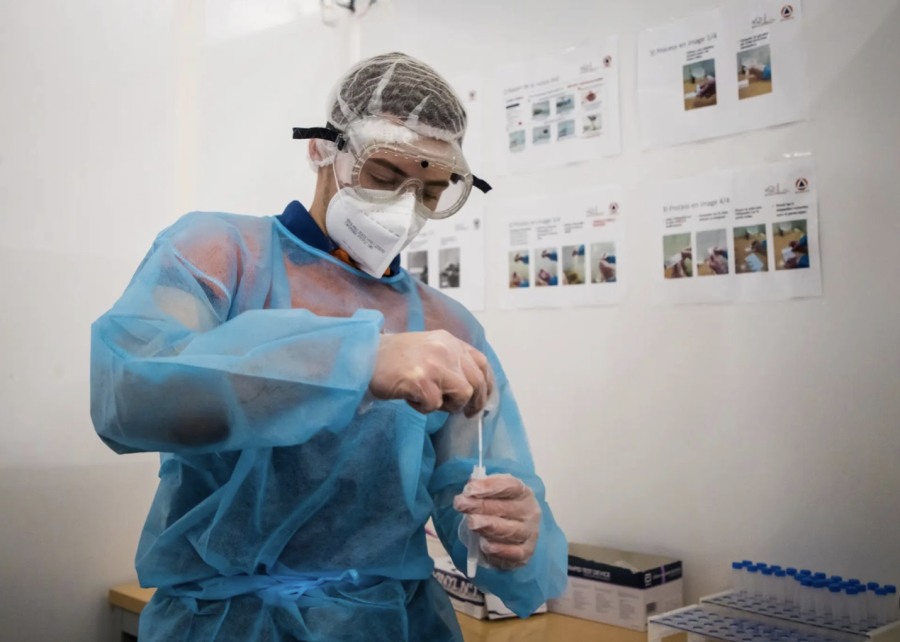“Deltacron”: Real or Fake?
The New York Times: A medical assistant preparing a COVID-19 test for passengers coming to Charles de Gaulle Airport, Paris. January, 2022. Photographer: Christophe Petit Tesson from EPA
March 31, 2022
In recent weeks, researchers and scientists across multiple countries including the U.S. have discovered a new variant of the COVID-19 virus. Although the novel variant, unofficially dubbed as “Deltacron”, is manufactured from a combination of genes found in Delta and Omicron variants, it has not proved to be extremely severe or prevalent. Here is what is known so far about this hybrid which has been assigned a lurid Frankensteinian nickname.
The Facts
In February of 2022, Scott Nguyen, a laboratory scientist and an employee with the Washington, D.C, Public Health Laboratory, was inspecting an international collection of coronavirus genomes entitled GISAID. According to an article by The New York Times, Dr. Nguyen noticed samples from France which were equipped with a combination of genes from two different variants, noticeably Delta and Omicron. Medical specialists and scientists refer to these viruses as recombinants. However, Nguyen was prudent to initially display his findings to the populace.
“There’s a lot of proof that’s needed to show that it is real,” Dr. Nguyen assured.
After sharing his suspicions to a digital, collaborative forum called covlineages, where scientists check one another’s credibility regarding new variants, several researchers in Europe elucidated their confirmation. One such member, a virologist at the Institut Pasteur located in Paris, confirmed the existence of Deltacron samples. Etienne Simon-Loriere and his colleagues have since furthered their critical study of the recombinant in a laboratory setting.
Among the 29,719 positive COVID-19 samples accrued and sequenced in San Mateo, California’s lab Helix, which closely cooperates alongside the Centers for Disease Control, a mere two infections were discovered in the United States which dealt with altered versions of Deltacron. Twenty other infections involved instances of Delta and Omicron which had been not infused and existed separately.
According to the World Health Organization, thirty-three cases of the new COVID-19 variant have been uncovered in France, eight in Denmark, and one in Germany and the Netherlands.
Identification of Danger
Despite popular sentiments, the detected recombinant is extremely uncommon and does not possess the foreseeable potential to grow rapidly.
According to Dr. Simon-Loriere, the gene that encodes Deltacron’s surface protein, or spike, is found primarily in Omicron. The entirety of the genome can be derived from Delta. The spike protein is one of the chief portions of a COVID-19 virus, which allows it to permeate the boundaries of host cells and infect the surrounding cells. It is also the prime target for antibodies. This means that the requisite safeguards against Omicron, including vaccinations and masks, function the same when it comes to the new recombinant virus.
In terms of cases in the United States, William Lee, the chief scientific officer at Helix lab, claimed in a statement to USA TODAY that excessive worry regarding Deltacron was unfounded, “The fact that there is not that much of it, that even the two cases we saw were different, suggests that it’s probably not going to elevate to a variant of concern level.”
Even more, recombinations of existing viruses are conventionally short-lived. Past behaviors of Omicron also corroborate the fact that Ddeltacron’s spike protein doesn’t invade as well in a proprietor’s lungs.
Recombinant Viruses
Although recombinant viruses are rare, they can still occur in our everyday lives. If one is in a crowded environment, then they have the likelihood of ingesting viruses from more than one infected person.
Biologically, recombinant viruses result from two different viruses invading the same cell and synthesizing within the same moment. Once the invaded cell begins to manufacture new viruses, then the amalgamated genetic makeup produces a new, hybrid virus.
Deltacron?
In the scientific community, the new hybrid is being referred to as the AY.4/BA.1 recombinant virus. Naturally, the public has vouched for a more simplified moniker.
According to the official system that scientists use to name new mutations of coronavirus, recombinant viruses are often granted with a two-letter abbreviation beginning with X. There is speculation that Dr. Nguyen’s new virus will be delegated XD.
Although the new virus should not be a source of extreme concern, it is still considered a phenomenon among scientists and researchers.
Mutations are not a new development, in fact, they occur more rapidly than humans can detect. But Deltacron is different, in the way that many different mutations were enduring at once as a result of the continued presence of Delta and Omicron waves.
This new virus development only serves to reinforce and justify the country’s ongoing safety suggestions. It is crucial that scientists continue to investigate the virus and the current systems of protection are preserved, like vaccines and masks.































